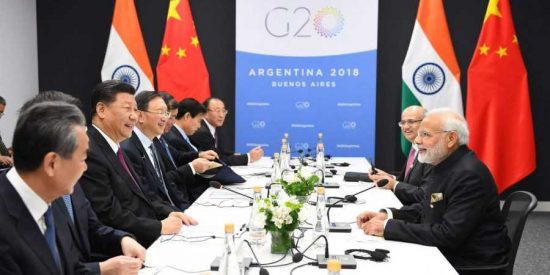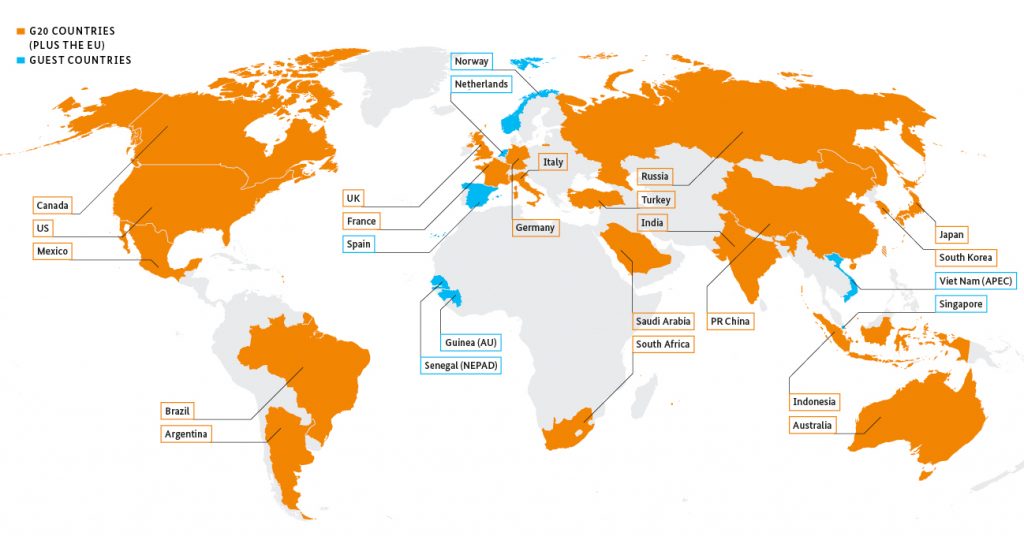Group of Twenty (G20) & India – Prospects & Challenges

The G20 Summit is formally known as the ‘Summit on Financial Markets and the World Economy.’ As the ‘premier forum for international economic corporation’ accounting for more than 80% of the global GDP, the G20 has made sustained efforts towards bringing robust global economic growth.
The recent summits of G20 not only focus on macroeconomy and trade but also focus on global issues which directly or indirectly impact the global economy. Some of the examples include health, migration, climate change, water crisis, terrorism, etc.
What is G20?
- G20 is an international forum that brings together the world’s 20 leading industrialised and emerging economies.
- It consists of 19 countries and the European Union.
- It is a forum for economic, financial and political cooperation.
- It seeks to address the major global challenges and generate public policies that resolve them.
What is the origin and evolution of G20?
- After the Asian Financial Crisis in 1997-1998, it was acknowledged that the participation of major emerging market countries is needed on discussions on the international financial system, and G7 finance ministers agreed to establish the G20 Finance Ministers and Central Bank Governors meeting in 1999.
- With the start of the global financial crisis of 2008, the G20 became the main instrument to face the crisis. And for that, it was essential to involve the highest-ranking officials. Therefore, presidents and heads of state participated in the G20 summits.
Who are the members of G20?
MJ GUUSSIF IS BACCTERIA
- Mexico
- Japan
- Germany
- United States
- United Kingdom
- South Africa
- South Korea
- India
- France
- Indonesia
- Saudi Arabia
- Brazil
- Argentina
- China
- Canada
- Turkey
- European Union
- Russia
- Italy
- Australia
Spain is a permanent guest and always participates in the G20 summits. Every year, the host country also chooses other guests.
What is the presidency of G20 & who assumes it?
- Every year, G20 members elect a country to preside over the group.
- The country that assumes the presidency organizes the meetings, defines the agenda of priorities to be debated and decides which countries and organizations to invite.
- As the G20 does not have a central organization, the role of the country presiding over the group is critical to the effectiveness of the forum.
- The president is chosen by a rotation system. For this, the 19 member states of the G20 (the 20th member, which is the European Union, is not part of a group of countries) are divided into 5 groups, comprising of a maximum of four states:
- Group 1: Australia, Canada, United States, Saudi Arabia.
- Group 2: India, Russia, South Africa, Turkey.
- Group 3: Argentina, Brazil, Mexico.
- Group 4: France, Germany, Italy, United Kingdom.
- Group 5: China, Indonesia, Japan, South Korea.
How does the G20 function?
The G20 agenda is annual and includes more than 50 meetings, enhanced by working groups and discussions between permanent members and guests.
The cycle concludes with the Leaders Summit, where a final declaration is signed by which the leaders commit themselves to resolve and collaborate on the issues addressed.
The flow of these meetings is channeled through 2 channels: The Finance Channel and The Sherpas Channel.
The Finance Channel: covers meetings between finance ministers and central bank governors, as well as meetings of their second lines and working groups on financial issues. In their meetings throughout the year, they focus on global collaboration in financial and monetary policies, which may include issues such as investment in infrastructure, fiscal policy, inclusion, and financial regulation.
The Sherpas Channel, meanwhile, covers non-financial issues – political commitment, the fight against corruption, development, gender equality, trade and energy, climate change, etc.
- Each member country of the G20 is represented at the meetings by the Sherpa and the minister that corresponds to the subject.
- The Sherpa then advises his Head of State or Government on the issues discussed and brings the dialogue to the relevant working groups.
- (note: A Sherpa is a personal representative of the leader of a member country at an international Summit meeting such as the G8, G20 or the Nuclear Security Summit and are responsible for thrashing out the details before the meeting of the leaders. )
Major international organizations are invited to participate in the meetings and the Leaders’ Summit for increasing the scope and impact of the G20, and ensuring that the approach is truly global.
G20 Troika: Every year, when a new country assumes the presidency, it works together with the previous presidency and the next presidency in what is known as the troika. This ensures continuity in the group’s agenda.
G20 Affinity Groups: through which civil society participates and makes recommendations on various issues. Currently, affinity groups in G20 are: Business 20 (B20), Civil 20 (C20), Labor 20 (L20), Science 20 (S20), Think 20 (T20), Women 20 (W20), Youth 20 (Y20).
HQ: The G20 does not have permanent offices or employees. The country that presides over the group (in a year) takes care of all the organizational needs and the logistical coordination of the meetings.
The Common Framework for debt treatment beyond the DSSI (Common Framework) is an initiative of the G20, together with the Paris Club to support Low-Income Countries with unsustainable debt in a structural manner.
What is the significance of G20?
- G20 members constitute
- 85% of world GDP,
- 2/3rd of its population,
- 75% of international trade,
- 80% of global investments in research & development.
- Influence policies & cooperation: As G20 is a forum, its agreements or decisions have no legal impact but they do influence countries’ policies and global cooperation.
- Flexible: With only 20 members, the G20 is agile enough to make prompt decisions and to adapt to new challenges.
- Inclusive & effective: This is far more inclusive and representative than the G8, which the G20 has largely displaced, and more than adequate to make agreements to act collectively credible and effective.
- Better Communication: G20 bring World’s top developed and developing countries together to bring consensus and reasoning into the decision making through discussion.
- Relevance in changing times: As globalization progresses and various issues become more intricately intertwined, the recent G20 summits have focused not only on macroeconomy and trade, but also on a wide range of global issues which have an immense impact on the global economy, such as development, climate change and energy, health, counter-terrorism, as well as migration and refugees. The G20 has sought to realize an inclusive and sustainable world through its contributions towards resolving these global issues.
What are the major achievements of G20?
- Increased participation of emerging countries in global issues.
- Facilitated an increase in lending from multilateral development banks of US$235 billion at a time when private-sector sources of finance were diminished.
- Major achievements of the G20 include the quick deployment of emergency funding during the 2008 global financial crisis.
- It also works for reforms in international financial institutions by improving oversight of national financial institutions. Ex- G20 driven reforms to the international tax system, through the G20/OECD Base Erosion and Profit Shifting (BEPS) project and implementation of tax transparency standards.
- G20 played a critical role in the ratification of the Trade Facilitation Agreement, with the WTO estimating it could contribute up to somewhere between 5.4 and 8.7% to global GDP by 2030 if the agreement were fully implemented.
What are the drawbacks & challenges of G20?
Exclusion:
- The process of determining which nations were to be invited or not to join the G20 has been very informal.
- A 2011 report had criticised the G20’s exclusivity, highlighting, in particular, its under-representation of the African continent.
- Identification of important economies of the world is based on just assumption rather than through criteria such as population, GDP, financial reserves, etc.
Transparency & accountability: The G20’s transparency and accountability have been questioned by critics, who highlights the absence of a formal charter and the fact that the most important G20 meetings are closed-door.
No permanent secretariat: The informal structure of the G20, with a rotating chair and no permanent secretariat, means that agendas are determined each year by the chair and so can swing widely, and formal mechanisms to monitor follow-through on countries’ public commitments are weak.
No Enforcement mechanism: The G20’s toolkit ranges from simple exchanges of information and best practices to agreeing common, measurable targets, to coordinated action. None of this is achieved without consensus, nor is it enforceable, except for the incentive of peer review and public accountability.
Not legally binding: the decisions are based on discussions and consensus which culminates in the form of declarations. These declarations are not legally binding. It’s just an advisory or consultative group of 20 members.
Ineffectiveness:
- Finance ministers and heads of state now come to the table with their hands tied, their positions determined in advance by their governments and a formal script that prevents meaningful and creative compromises.
- The effective implementation of commitments is even weaker than the ability of leaders to forge meaningful agreements in the first place. It is because of the lack of ability to enact those agendas.
- The G20 summit has in effect become a G30 as countries unhappy about being left out of the club have participating anyway.
Way forward
The G20 cannot be a panacea for the world’s problems. But over the past decade, the G20 has been an important forum for international cooperation. Effective global governance, like the G20, is essential for emerging powers who are seeking opportunities to influence and contribute to the global order.
G20 Summit 2019
- Recently the 14thG20 Summit was held in Osaka, Japan on 28th-29th June 2019.
- The summit discussed 8 themes to ensure global sustainable development. The eight themes were “Global Economy”, “Trade and Investment“, “Innovation”, “Environment and Energy“, “Employment”, “Women’s empowerment“, “Development” and “Health”.
- Indian PM (his sixth G-20 summit) held many plurilateral meetings with other world leaders like heads of Russia, USA, Japan, China, etc.
- Along with that, India also participated in two parallel tri-laterals i.e the Russia-India-China (RIC) and Japan-U.S.-India (JAI) and an informal BRICS summit.
- JAI Trilateral: Three countries discussed issues of the Indo-Pacific region, connectivity and infrastructure development. It was the second Japan-America-India (JAI) meeting.
- Informal BRICS meet: India stressed the need to stop all the mediums of support to terrorism and racism. Indian PM called terrorism “the biggest threat to humanity” which kills innocent and severely affects economic development and social stability.
- India and the US discussed various bilateral and global issues including Iran, 5G communications networks, trade, and defence ahead of the G-20 Summit.
- India targeted to become a five-trillion dollar economy in the next five years.
- Further India pledged to make Social sector as its top priority and resolve to focus on infrastructure development, especially digital infrastructure.
- However, Indian PM also highlighted the deficiency of resources, underlining that there is a shortfall of almost $1.3 trillion investment in the infrastructure.
- On the sidelines of G-20 summit, India and Japan signed exchange of Letter of Intent on Ahmedabad – Kobe Sister City Partnership.
- India also invited the G20 countries to join a global coalition on disaster resilience, saying disasters require quick and effective remedial measures as they invariably affect the poor the most.
- India and Indonesia set an ambitious USD 50 billion targets for bilateral trade over the next six years.
If you like this post, please share your feedback in the comments section below so that we will upload more posts like this.


